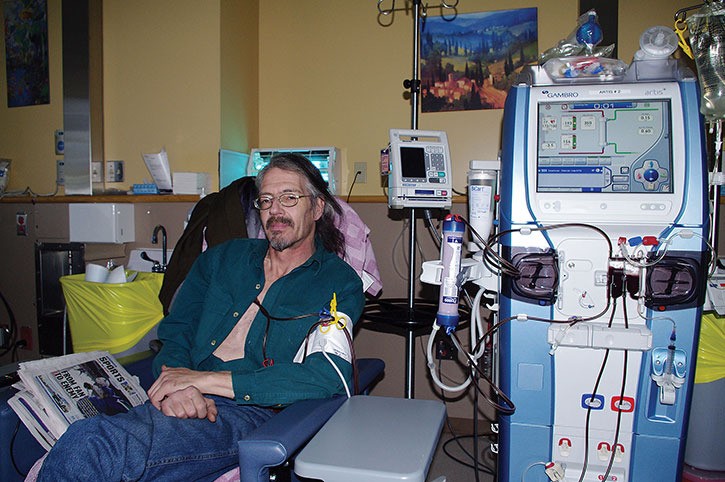The physical, emotional and financial strain of travelling to urban areas for dialysis has forced kidney disease patients to become prisoners of the road, but a 56-year-old Upper Columbia Valley resident could become the face for change in the East Kootenay region through the use of a telehealth clinic pilot program.
Kirt Sellers has begun travelling to the East Kootenay Regional Hospital (EKRH) in Cranbrook to use an Interior Health-based video conference format (commonly known to health care professionals as telehealth clinics). The telehealth clinics allow Sellers to follow up with a Trail-based health care team, which includes a doctor, a social worker and a transplant nurse, as opposed to travelling 362 kilometres (four hours each way) to Trail to meet with the team in person for routine follow up post-kidney transplant appointments.
“With a focus on telehealth, I have certainly saved money in the sense that as a part of my renal follow up, they like to meet with me every three months, which translates to roughly four times annually which is a part of the normal protocol,” explained Mr. Sellers. “Instead of going to Trail to meet with them three or four times a year, I now go to Cranbrook three times a year and once a year to Trail.”
Sellers is merely one of many Interior Health patients who travel long distances for specialty appointments.
Kim McDuff, transplant redesign project co-ordinator, and her colleagues at the Kootenay Boundary Regional Hospital Kidney Transplant Clinic in Trail, identified a strong desire to develop alternative options for patients who are required to drive long distances for follow up appointments. The staff used this as the foundation for the developing a pilot program that allows post-transplant patients to attend their follow up clinic appointments in Cranbrook, connecting to Trail through telehealth.
“Telehealth offers a way to provide adequate and continuous care for post-transplant patients not living in Trail,” said Ms. McDuff in a recent press release.
The telehealth pilot program ran from November 2014 to May 2015 with 12 patients using the service. The appointments were offered in collaboration with Interior Health and BC Transplant.
The follow up appointments are conducted at the EKRH in Cranbrook, which allows renal nurse Georgi Winger, to check a patient’s blood pressure, weight, pulse and edema (excess of fluid) and relays the information through telehealth to the Trail Kidney Transplant Clinic.
“Although we’ve only been doing telehealth with post-transplant patients for a short time, the feedback has been nothing but positive,” said Ms. Winger in a recent press release. “They are so grateful to be able to meet with the transplant team and receive the care they need without having to take the time to travel to Trail.”
The goal of the program was to reduce the emotional and financial stress that many patients experienced with the hopes of boosting their overall health and
well-being.
“It’s expensive for people to take an unpaid day off work and stressful to drive the mountain pass to Trail,” said Teresa Buckley, a transplant clinic nurse, nephrologist, social worker and dietician, in the release. “With telehealth, this health-care service is more accessible and increases the continuity of care.”
Interior Health is evaluating rural sites that could potentially facilitate appointments for pre-transplant patients and Sellers remains optimistic that the Columbia Valley could become the next home for renal care.
“I’d like to see these services expanded and be offered here,” concluded Sellers, noting there’s a demand for telehealth in the Columbia Valley. “Driving to Cranbrook on a regular basis is hard enough, especially in winter. My heart goes out to anybody who is doing that trip on a regular basis. A lot of those services can be delivered through telehealth and it’s invaluable.”
